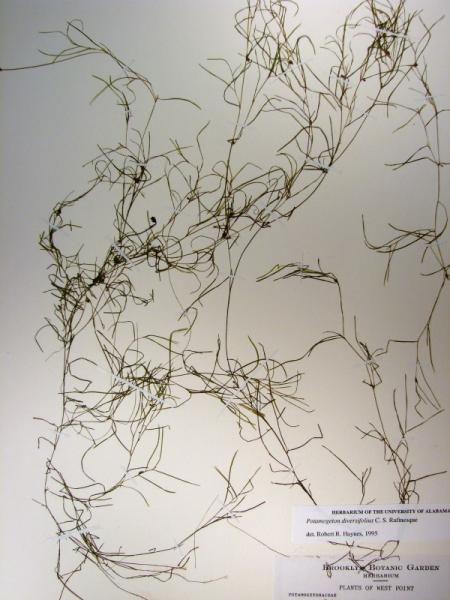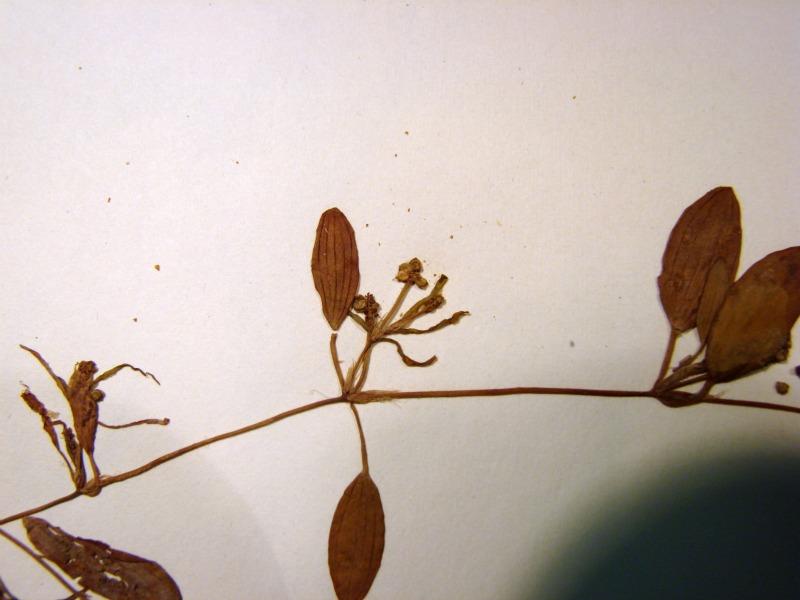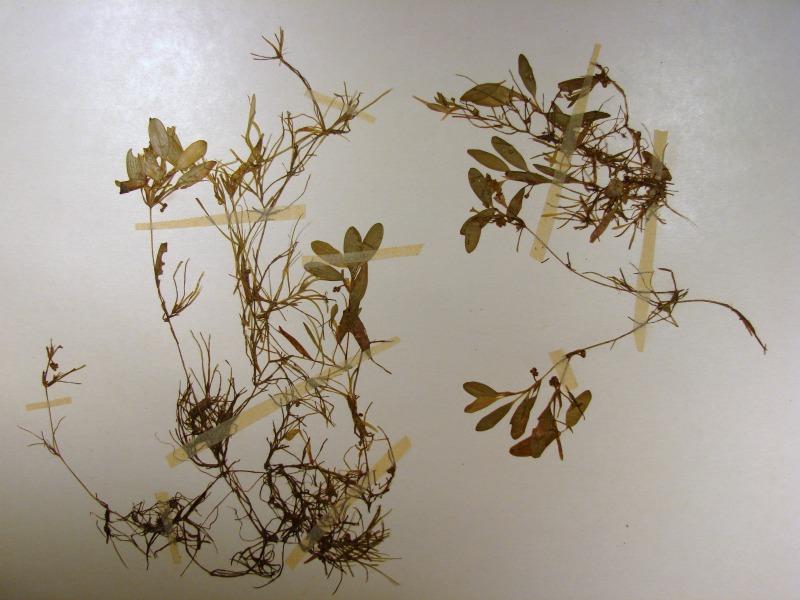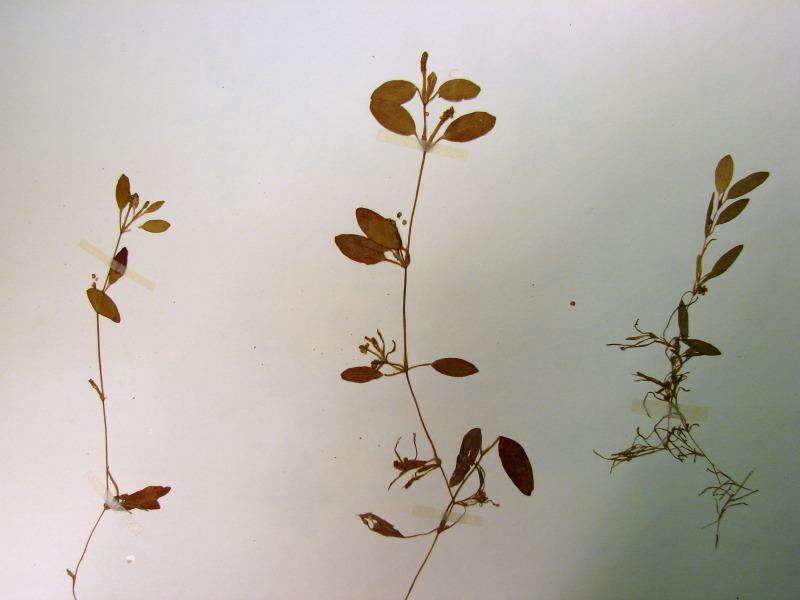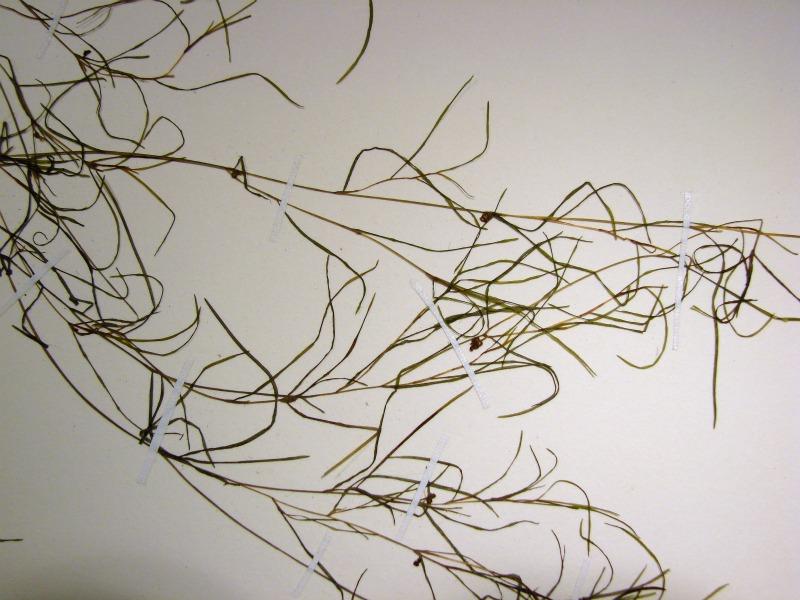Southern Snailseed Pondweed
Potamogeton diversifolius Raf.
- Class
- Monocotyledoneae (Monocots)
- Family
- Potamogetonaceae (Pondweed Family)
- State Protection
- Endangered
Listed as Endangered by New York State: in imminent danger of extirpation in New York. For animals, taking, importation, transportation, or possession is prohibited, except under license or permit. For plants, removal or damage without the consent of the landowner is prohibited.
- Federal Protection
- Not Listed
- State Conservation Status Rank
- S1
Critically Imperiled in New York - Especially vulnerable to disappearing from New York due to extreme rarity or other factors; typically 5 or fewer populations or locations in New York, very few individuals, very restricted range, very few remaining acres (or miles of stream), and/or very steep declines.
- Global Conservation Status Rank
- G5
Secure globally - Common in the world; widespread and abundant (but may be rare in some parts of its range).
Summary
Did you know?
The specific epithet diversifolius means diverse leaved (Fernald 1970). This is probably in reference to the differences in the submersed and floating leaves although, this character is shared by many other pondweed species.
State Ranking Justification
There are 7 known extant populations and about 19 populations which have not been seen in recent years and are considered historical. Many of the specimens documenting these populations may be misidentified as this species has clearly been misunderstood in the past. This species is at the northern edge of its range in New York and many of its historical locations have probably been destroyed in the urbanized area of New York City.
Short-term Trends
All seven known extant populations were first documented within the past 25 years. It is unclear if these are new populations or simply have been overlooked in the past. Overall, short term trends are not clear.
Long-term Trends
There are about 19 populations which have not been seen in recent years and are considered historical. The number of populations is not exactly clear as many specimens are probably misidentified given the complex taxonomic history of this species. Many of the historical populations occurred within what is now the urbanized region of New York City. These population have likely become extirpated. The other historical populations may still be extant but they simply have not been searched for. There are seven known extant populations which were first documented within the past 25 years. It is unknown if these are truly new populations or were simply overlooked in the past. Overall, long term trends are not clear but probably indicate at least a slight decline.
Conservation and Management
Threats
Currently there are no known threats to this species.
Conservation Strategies and Management Practices
No management is currently needed.
Research Needs
Many specimens documenting populations have not been annotated recently and need to be verified. Historical populations need to be surveyed to determine if these populations are still extant.
Habitat
Habitat
In New York, this species primarily occurs in ponds (including dammed ponds) usually on the margins where the water is shallow and in deep emergent marshes. Some of the populations occur in areas with dense aquatic vegetation. It also is known from ditches (New York Natural Heritage Program 2008). Ponds, lakes, streams, and rivers (Haynes and Hellquist 2000).
Associated Ecological Communities
- Coastal plain pond
(guide)
The aquatic community of the permanently flooded portion of a coastal plain pond with seasonally, and annually fluctuating water levels. These are shallow, groundwater-fed ponds that occur in kettle-holes or shallow depressions in the outwash plains south of the terminal moraines of Long Island, and New England. A series of coastal plain ponds are often hydrologically connected, either by groundwater, or sometimes by surface flow in a small coastal plain stream.
- Deep emergent marsh
(guide)
A marsh community flooded by waters that are not subject to violent wave action. Water depths can range from 6 in to 6.6 ft (15 cm to 2 m). Water levels may fluctuate seasonally, but the substrate is rarely dry, and there is usually standing water in the fall.
- Eutrophic pond*
(guide)
The aquatic community of a small, shallow, nutrient-rich pond. The water is usually green with algae, and the bottom is mucky. Eutrophic ponds are too shallow to remain stratified throughout the summer; they are winter-stratified, monomictic ponds.
- Oligotrophic pond
(guide)
The aquatic community of a small, shallow, nutrient-poor pond. The water is very clear, and the bottom is usually sandy or rocky.
- Reservoir/artificial impoundment
The aquatic community of an artificial lake created by the impoundment of a river with a dam. Reservoirs are constructed to collect water for municipal and/or agricultural water use, to provide hydroelectric power, and to improve opportunities for recreational activities (e.g., boating, swimming), and development.
- Tidal river*
(guide)
The aquatic community of a river under the influence of daily lunar tides. We restrict this community to the continuously flooded portions of the river where plants do not grow out of the water. A deepwater zone has depths averaging more than 2 m (6 ft) at low tide. Salinities at any one place in the river may fluctuate as the tides flow in and out.
* probable association but not confirmed.
Associated Species
- Bidens beckii (Beck's water-marigold)
- Brasenia schreberi (water-shield)
- Ceratophyllum echinatum (spiny-fruited coon-tail)
- Nuphar variegata (common yellow pond-lily, common spatter-dock)
- Nymphaea odorata
- Potamogeton amplifolius (big-leaved pondweed)
- Potamogeton pulcher (spotted pondweed)
Range
New York State Distribution
This species is mostly restricted to southeastern New York with perhaps some populations in western New York. The specimens representing some of these populations as well as others that have been annotated as P. diversifolius from other parts of the state are most likely misidentified and need to be verified before a full picture of this species range in New York can be ascertained (New York Natural Heritage Program 2008).
Global Distribution
This species is a wide ranging taxon south and west of New York. It occurs from Connnecticut and New York south to Florida and west to Minnesota, Oregon and California. It is also known from Mexico (Reznicek and Babbette 1976, Haynes and Hellquist 2000).
Identification Comments
General Description
This species is a submerged, or sometimes floating-leaved, aquatic plant. It has rhizomes and the main stems are up to 35 cm long. It has narrow, linear, submerged leaves scattered along the stems and sometimes the upper ones have dilated leaf blades which float on the surface of the water. The flowers occur in clusters on stalks from the axils of the leaves and sometimes from the end of the stem. These flowers mature to small rounded fruits with three narrow ridges or wings (Haynes and Hellquist 2000).
Best Life Stage for Proper Identification
Mature fruits are a help in identifying this species and while not completely necessary for an accurate identification they are extremely useful. Well prepared and complete specimens are extremely important for identification. In particular, full leaves that have not been broken, so their length can be assessed, are important. Specimens should be prepared by putting floating plants onto a sheet of heavy paper.
Similar Species
All leaf measurement listed below should be done on mature leaves from the middle of the stems. Leaves that are dilated or show a transition towards dilation (even slightly) should be avoided. Also, leaves from seedling plants and from late season shoots that proliferate from the axils should be avoided. In addition, submersed leaf characters are less useful in plants from flowing water habitat.
Potamogeton spirillus has the adnate portion of the stipule mostly longer than the free portion; fruits with a single dorsal keel and smooth rounded sides; submersed peduncles 0.5-3.0 mm long; and submersed middle stem leaves (do not use leaves with dilated apices) 15-80 times as long as wide. Compared to adnate portion of the stipule shorter than the free portion; fruits with a dorsal keel and two lateral keels; submersed peduncles 3-5 mm long; and submersed middle stem leaves 20-150 (280) times as long as wide for P. diversifolius (Reznicek and Bobbette 1976, Haynes and Hellquist 2000). There is some discrepancy in the literature regarding the lateral keels of the fruits so, caution should be used with this character (See Reznicek and Bobbette 1976, Haynes and Hellquist 2000).
Potamogeton bicupulatus has the middle stem leaves 190-500 (600) times as long as wide, usually 0.1-0.4 (0.6) mm wide (averaging 0.2 mm), and with lacunae present; and apices of floating leaves acute. Compared to middle stem leaves 20-150 (280) times as long as wide, usually 0.3-1.5 mm wide (averaging 0.54 mm), and lacunae absent; and apices of floating leaves usually obtuse for P. diversifolius (Reznicek and Bobbette 1976, Haynes and Hellquist 2000).
Best Time to See
Fruits are produced from August through September. Therefore, the best time to survey for this species is during this time period.
- Vegetative
- Fruiting
The time of year you would expect to find Southern Snailseed Pondweed vegetative and fruiting in New York.
Southern Snailseed Pondweed Images
Taxonomy
Southern Snailseed Pondweed
Potamogeton diversifolius Raf.
- Kingdom Plantae
- Phylum Anthophyta
- Class Monocotyledoneae
(Monocots)
- Order Najadales
- Family Potamogetonaceae (Pondweed Family)
- Order Najadales
- Class Monocotyledoneae
(Monocots)
- Phylum Anthophyta
Additional Common Names
- Pondweed
Synonyms
- Potamogeton capillaceus Poir. pro parte [also misapplied to <i>P. bicupulatus</i>]
- Potamogeton capillaceus var. atripes Fernald
- Potamogeton diversifolius var. multidenticulatus Morong
Comments on the Classification
Potamogeton diversifolius is considered to be in subsection Hybridi by Fernald (1932) and Reznicek and Bobbette (1976). In North America, this subsection is represented by three taxa (P. diversifolius, P. bicupulatus, and P. spirillus) (Reznicek and Bobbette 1976). In their Flora of North America treatment, Haynes and Hellquist (2000) do not recognize infrageneric categories stating that, "after studying thousands of specimens [of Potamogeton] over five continents, we believe that recognition of many infrageneric categories is unwarranted." The three NA species in subsection Hybridi (as circumscribed by Reznicek and Bobbette 1976) have a confusing taxonomic and nomenclatural history which appears to have been resolved by Reznicek and Bobbette (1976). Their conclusion to recognize three taxa has been followed by Haynes and Hellquist (2000) and Gleason and Cronquist (1991) although, Gleason and Cronquist (1991) chose to recognize two of these taxa at the variety (compared to the species) level in opposition to Reznicek and Bobbette's (1976) conclusions. According to Fernald (1932), P. diversifolius has often been confused with P. spirillus. Therefore, as Fernald suggests, the identity of specimens labeled P. spirillus should be compared with P. diversifolius. Although in New York, P. diversifolius is quite a rarity while P. spirillus is much more widespread. Fernald (1932, 1970) recognized three species in subsection Hybridi besides P. spirillus (P. diversifolius, P. capillaceus, and P. bicupulatus). Klekowski and Beal (1965) found that Potamogeton diversifolius is not distinct from P. capillaceus. Upon further work, Reznicek and Bobbette (1976) found that besides for P. spirillus, there are only two distinct taxa and these, a fine leaved more northern species and a wider leaved more southern species, are worthy of r
Additional Resources
Best Identification Reference
Reznicek, A.A. and R.S.W. Bobbette. 1976. The taxonomy of Potamogeton subsection Hybridi in North America. Rhodora 78: 650-673.
Other References
Crow, Garrett E. and C. Barre Hellquist. 2000. Aquatic and wetland plants of northeastern North America: A revised and enlarged edition or Norman C. Fassett's a manual of aquatic plants. Volume two angiosperms: Monocotyledons. The University of Wisconsin Press. Madison, Wisconsin. 456 pp.
Fernald, M.L. 1932. The linear-leaved North American species of Potamogeton section Axillaries. Memoirs of the American Academy of Arts and Sciences17: 1-183.
Fernald, M.L. 1950. Gray's manual of botany. 8th edition. D. Van Nostrand, New York. 1632 pp.
Gleason, Henry A. and A. Cronquist. 1991. Manual of Vascular Plants of Northeastern United States and Adjacent Canada. The New York Botanical Garden, Bronx, New York. 910 pp.
Haynes, R.R. and C.B. Hellquist. 2000. Potamogetonaceae Dumortier. Pages 47-74 in Flora of North America Editorial Committee (Editors), Flora of North America, North of Mexico, Volume 22, Magnoliophyta: Alismatidae, Arecidae, Commelinidae (in part), and Zingiberidae. Oxford University Press, New York, New York, USA.
Hellquist, C.B. and G.E. Crow 1980. Aquatic Vascular Plants of New England: Part 1. Zosteraceae, Potamogetonaceae, Zannichelliaceae, Najadaceae. New Hampshire Agricultural Experiment Station University of New Hampshire. Station Bull. 515.
Holmgren, Noel. 1998. The Illustrated Companion to Gleason and Cronquist's Manual. Illustrations of the Vascular Plants of Northeastern United States and Adjacent Canada. The New York Botanical Garden, Bronx, New York.
Klekowski, E.J. Jr. and E.O. Beal. 1965. A study of variation in the Potamogeton capillaceus-diversifolius complex (Potamogetonaceae). Brittonia 17: 175-181.
Mitchell, Richard S. and Gordon C. Tucker. 1997. Revised Checklist of New York State Plants. Contributions to a Flora of New York State. Checklist IV. Bulletin No. 490. New York State Museum. Albany, NY. 400 pp.
New York Natural Heritage Program. 2010. Biotics database. New York Natural Heritage Program. New York State Department of Environmental Conservation. Albany, NY.
New York Natural Heritage Program. 2024. New York Natural Heritage Program Databases. Albany, NY.
Ogden, E.C. 1974. Anatomical patterns of some aquatic vascular plants of New York. New York State Museum Bull. 424.
Reschke, Carol. 1990. Ecological communities of New York State. New York Natural Heritage Program, New York State Department of Environmental Conservation. Latham, NY. 96 pp. plus xi.
Rhoads, Ann F. and Timothy A. Block. 2000. The Plants of Pennsylvania, an Illustrated Manual. University of Pennsylvania Press, Philadelphia, PA.
Seymour, F.C. 1982. The flora of New England. A manual for the identification of all vascular plants including ferns and fern allies growing without cultivation in New England. Moldenka, Plainfield, New Jersey.
Taylor, Norman. 1915. Flora of the vicinity of New York. Memoirs of the New York Botanical Garden vol. V. New York, NY.
Voss, E.G. 1972. Michigan Flora, Part I. Gymnosperms and Monocots. Cranbrook Institute of Science Bulletin 55 and the University of Michigan Herbarium. Ann Arbor. 488 pp.
Weakley, A. S. 2007. Flora of the Carolinas, Virginia, Georgia, and surrounding areas. Working draft of 11 January 2007. University of North Carolina Herbarium (NCU), North Carolina Botanical Garden, University of North Carolina at Chapel Hill. Online. Available: http://www.herbarium.unc.edu/flora.htm (accessed 2007).
Weldy, T. and D. Werier. 2010. New York flora atlas. [S.M. Landry, K.N. Campbell, and L.D. Mabe (original application development), Florida Center for Community Design and Research http://www.fccdr.usf.edu/. University of South Florida http://www.usf.edu/]. New York Flora Association http://newyork.plantatlas.usf.edu/, Albany, New York
Weldy, Troy W. and David Werier. 2005. New York Flora Atlas. [S.M. Landry, K.N. Campbell, and L.D. Mabe (original application development), Florida Center for Community Design and Research. University of South Florida]. New York Flora Association, Albany, NY. Available on the web at (http://newyork.plantatlas.usf.edu/).
Links
About This Guide
Information for this guide was last updated on: December 22, 2008
Please cite this page as:
New York Natural Heritage Program. 2024.
Online Conservation Guide for
Potamogeton diversifolius.
Available from: https://guides.nynhp.org/southern-snailseed-pondweed/.
Accessed July 27, 2024.
